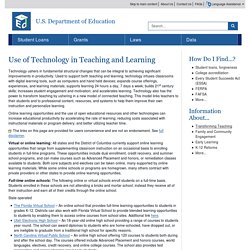

Teaching teachers to use blended-learning education technology. Stolk/Thinkstock It seems a waste.

Millions of educational apps, millions of lesson plans available online, millions of laptops in the hands of students. Yet only a small segment of teachers nationwide find ways to infuse technology into their lessons. “There’s a real hunger out there, about how do I get better at my craft?” Said Jeff Liberty, the senior director of teacher development initiatives at BetterLesson, which trains teachers to use technology in class.
The resources exist; the desire is there. A 2015 survey of teachers found that 90 percent felt technology was important for classroom success, while almost two-thirds wanted to integrate it into their lessons but said they needed more training. The teachers who succeed in adding technology to their teaching usually spend their own time to figure out how to use new tools—sitting up late at night digging through YouTube videos and trolling Twitter chats. Now a nonprofit and several companies founded by teachers have stepped in. Technology in Education - School - Students, Schools, Instructional, and Educational. Center for Teaching and Learning.
Teaching with technology can deepen student learning by supporting instructional objectives.

However, it can be challenging to select the “best” tech tools while not losing sight of your goals for student learning. Once identified, integrating those tools can itself be a challenge albeit an eye-opening experience. The CTL is here to help you (novice, expert and everyone in between) find creative and constructive ways to integrate technology into your class.
If you are looking to flip your class, make use of Canvas or simply want to experiment with some new instructional technologies, we can help. To arrange an appointment or consultation, please fill out the following form: Five Ways Teachers Can Use Technology to Help Students. Thomas Edison once said, “Books will soon be obsolete in the public schools…our school system will be completely changed inside of ten years.” Amazingly enough, however, one of our nation’s most important inventors was proven quite wrong. The American education system has a remarkable resistance to innovation and the classroom experience has changed very little in the 100 years since Edison’s prediction. Advances in information technology have revolutionized how people communicate and learn in nearly every aspect of modern life except for education.
The education system operates under the antiquated needs of an agrarian and industrial America. The short school day and the break in the summer were meant to allow children to work on family farms. Technology has failed to transform our schools because the education governance system insulates them from the disruptions that technology creates in other organizations. Use of Technology in Teaching and Learning. Technology ushers in fundamental structural changes that can be integral to achieving significant improvements in productivity.

Used to support both teaching and learning, technology infuses classrooms with digital learning tools, such as computers and hand held devices; expands course offerings, experiences, and learning materials; supports learning 24 hours a day, 7 days a week; builds 21st century skills; increases student engagement and motivation; and accelerates learning. Technology also has the power to transform teaching by ushering in a new model of connected teaching.
This model links teachers to their students and to professional content, resources, and systems to help them improve their own instruction and personalize learning. The links on this page are provided for users convenience and are not an endorsement. See full disclaimer. Full-time online schools: The following online or virtual schools enroll students on a full-time basis. State operated District operated. 12 Easy Ways to Use Technology in the Classroom, Even for Technophobic Teachers. Everyone wants teachers to use technology in the classroom. But you're busy -- meeting standards, prepping students for tests -- and maybe you’re not too fond of computers, anyway. Never fear – there are easy ways to bring your classroom up-to-date, technologically. Do you have a iPad in your classroom for your use?
How about iPads for students to use? Could you get a classroom iPad? What kind of Internet access is available at your school? Technology Integration Ideas that Work. Technology has become integrated in the classroom in so many ways, that we often don't even think about how we are using it.

What Is Successful Technology Integration? Technology integration is the use of technology resources -- computers, mobile devices like smartphones and tablets, digital cameras, social media platforms and networks, software applications, the Internet, etc. -- in daily classroom practices, and in the management of a school. Successful technology integration is achieved when the use of technology is: Routine and transparent Accessible and readily available for the task at hand Supporting the curricular goals, and helping the students to effectively reach their goals When technology integration is at its best, a child or a teacher doesn't stop to think that he or she is using a technology tool -- it is second nature.
10 of the Most Engaging Uses of Instructional Technology (with Dozens of Resources and Tools) Are you looking for ways to integration technology in your lesson plans and courses that provide for an engaging experience for you and your students?

Fans of instructional technology know that it can be fun and inviting, and engaged students are far more likely to be learning. I believe that if you can get students involved and motivated effectively enough, you can improve their learning habits over the long term. With that in mind, here are 10 highly engaging uses of technology in the classroom, along with dozens of tools and resources for implementation. Most of these involve free web based tools, so that's an added bonus! Interactive Collaboration The 2014 Gates Foundation report, Teachers Know Best: What Educators Want from Digital Instructional Tools, indicates that teachers want tools “supporting student collaboration and providing interactive experiences”. Gathering Feedback Embedding Questions in Videos Today’s students consume video like drinking water.